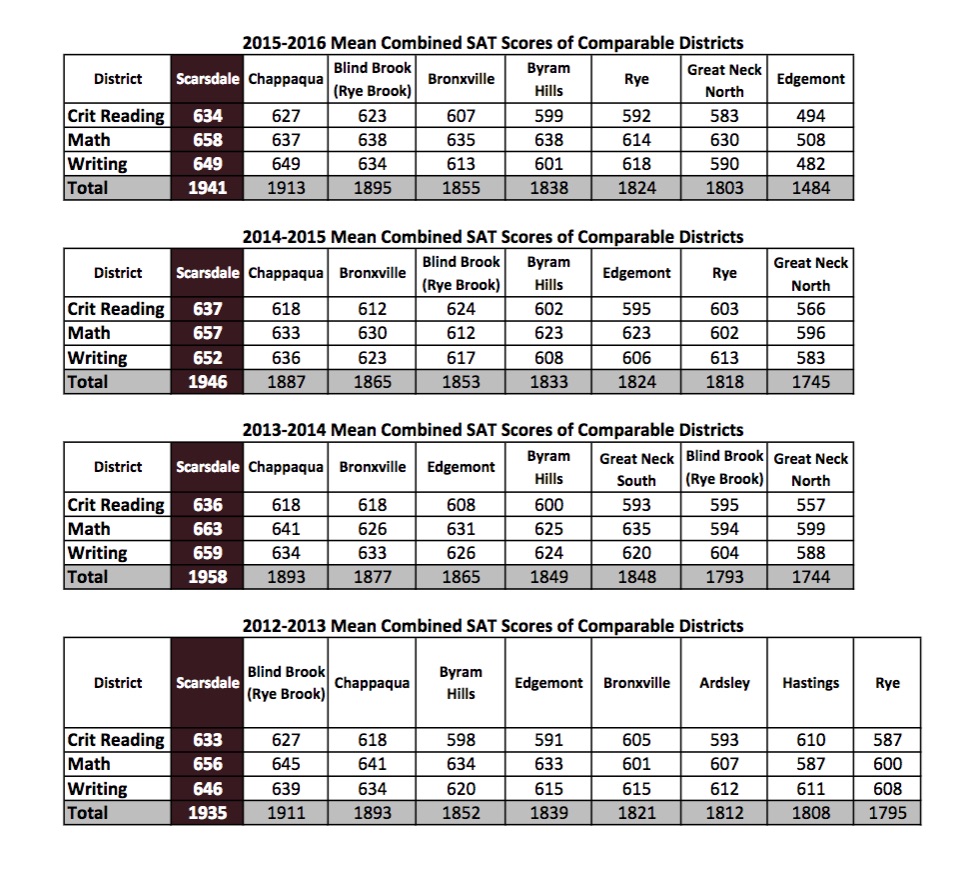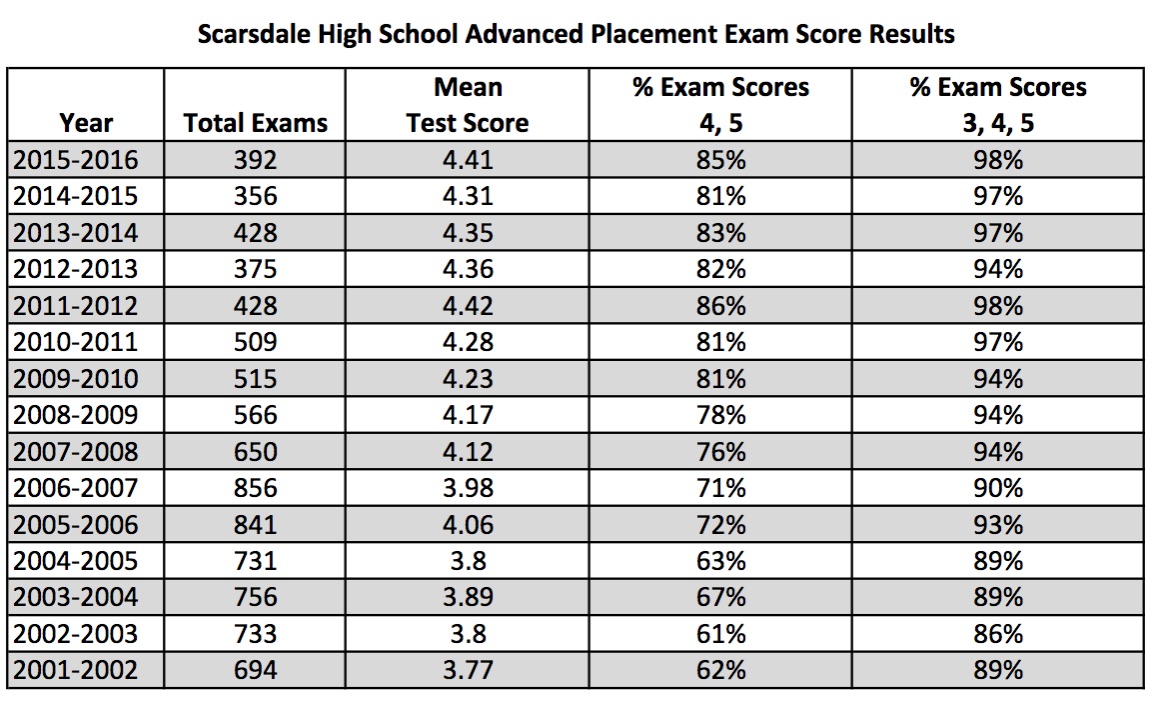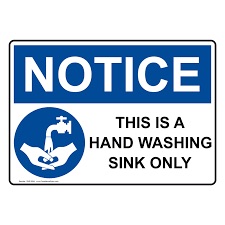Scarsdale Schools: Student Testing, Water Safety and New Health Policies
- Thursday, 17 November 2016 08:09
- Last Updated: Thursday, 17 November 2016 08:27
- Published: Thursday, 17 November 2016 08:09
- Heather Gilchriest Meili
- Hits: 7488
 Though dominated by construction and finance issues, the November 14 Scarsdale School Board meeting also included important information about student test results plus a report on water safety and new policies on head lice and concussions.
Though dominated by construction and finance issues, the November 14 Scarsdale School Board meeting also included important information about student test results plus a report on water safety and new policies on head lice and concussions.
Student Testing
Superintendent Thomas Hagerman turned the meeting back to "our core mission of teaching and learning" by introducing the "Student Assessment in Scarsdale Schools" report from Assistant Superintendent for Instruction Lynn Shain. In Ms. Shain's clear and thoughtful report (available for reading in full on the District website), she first placed Assessment in context as "one of the three, integral facets of the teaching and learning cycle along with curriculum and instruction," playing an essential role in allowing teachers to pinpoint students' needs, improve their instruction, and even adjust the curriculum to ensure the best learning outcomes.
 Next, Ms. Shain addressed a point of annual concern to parents: standardized testing. She emphasized that standardized testing is only one small piece of the broader, continuous assessment that occurs throughout the school year. It is the view of the district that "the best assessment of a student's achievement is still classroom performance as judged by a teacher who sees the student's work in a variety of situations over the course of a school year." As a "snapshot in time," standardized testing provides limited information which is less useful in terms of gauging individual students, although it can be of use for viewing District achievement over time.
Next, Ms. Shain addressed a point of annual concern to parents: standardized testing. She emphasized that standardized testing is only one small piece of the broader, continuous assessment that occurs throughout the school year. It is the view of the district that "the best assessment of a student's achievement is still classroom performance as judged by a teacher who sees the student's work in a variety of situations over the course of a school year." As a "snapshot in time," standardized testing provides limited information which is less useful in terms of gauging individual students, although it can be of use for viewing District achievement over time.
Digging deeper into a topic raised earlier this fall with the release of the 2015-2016 State Test results, Ms. Shain flagged a concern with those results. She explained that standardized tests fall into one of two categories: Norm-referenced Tests (e.g., SATs), and Criterion-referenced Tests (e.g. NYS Regents exams). The first type provides a score that compares a student's performance to that of students in a sample of peers. The second compares a student's performance to specific standards regardless of other examinees' scores. Parents should be aware that the current state tests "create a hybrid of these types causing major concerns about the accuracy and value of this data." In essence, they treat a Criterion test as if it were a Norm-Referenced test - a "mixed metaphor" - which is why this year's test results were issued with a letter from Ms. Shain urging parents not to place too much emphasis on the "ranking" shown on the results page. She noted that, fortunately, "most of our community understands the shortcomings of standardized tests."
this fall with the release of the 2015-2016 State Test results, Ms. Shain flagged a concern with those results. She explained that standardized tests fall into one of two categories: Norm-referenced Tests (e.g., SATs), and Criterion-referenced Tests (e.g. NYS Regents exams). The first type provides a score that compares a student's performance to that of students in a sample of peers. The second compares a student's performance to specific standards regardless of other examinees' scores. Parents should be aware that the current state tests "create a hybrid of these types causing major concerns about the accuracy and value of this data." In essence, they treat a Criterion test as if it were a Norm-Referenced test - a "mixed metaphor" - which is why this year's test results were issued with a letter from Ms. Shain urging parents not to place too much emphasis on the "ranking" shown on the results page. She noted that, fortunately, "most of our community understands the shortcomings of standardized tests."
 Nonetheless, standardized test results and other data do bring good news for Scarsdale students and the families who are investing in their educations here.
Nonetheless, standardized test results and other data do bring good news for Scarsdale students and the families who are investing in their educations here.
Despite the shortcomings of the NY State Tests, and the "dips" in scores that occurred statewide as the tests were adjusted and the bar raised in both 2009 and 2012, the charts above show Scarsdale 3rd-8th grade students performing consistently ahead of students in comparable districts, the lower Hudson region, and the state overall.
The news is equally good looking at high school level results. One example among many are Scarsdale's SAT scores, which have been the highest among comparable districts in the region for the last four years.
 And despite Scarsdale's move to an AT rather than AP curriculum, Scarsdale students perform exceptionally well on AP tests. In fact, 98% of Scarsdale students received scores of 3,4,5 for the 2015-16 school year.
And despite Scarsdale's move to an AT rather than AP curriculum, Scarsdale students perform exceptionally well on AP tests. In fact, 98% of Scarsdale students received scores of 3,4,5 for the 2015-16 school year.
Looking ahead to students' senior year and beyond, Ms. Shain points out that Scarsdale's College Data continues to be excellent, with 63% of graduates accepted to the most selective colleges. She says, "Many selective private institutions tell us they are nowhere close.... You cannot have such outcomes without a strong K-12 system."
Water Safety
District water is not testing as well as district students. Lead levels in 19% of 368 district school sinks are higher than acceptable. Assistant Superintendent for Business and Facilities Stuart Mattey outlined results of water testing that was communicated via email to distract families last week. Continuing the work of last spring which saw the testing of all water fountains, Scarsdale Schools has completed a second round of testing which targeted 368 sinks and other water outlets. Of that number, 69 (19%) came in above the recommended threshold.
According to the CDC, "Lead found in tap water usually comes from the corrosion of older fixtures or from the solder that connects pipes. When water sits in leaded pipes for several hours, lead can leach into the water supply."
Filters will be put in place, and in the meantime signs at each affected outlet warn "Handwashing Only."
Mr. Mattey reported that the total cost of filters and maintenance going forward will add about $32,000 annually to the budget. But in Dr. Hagerman's words, "The dollars are minimal compared to the other impact; we're committed to getting this taken care of as quickly as possible."
Head Lice
Eric Rauschenbach, Director of Special Education and Student Services, updated the Board on the latest policy updates, beginning with the issue with the "ick factor: lice! Fortunately, although there are always occasional incidents, the district has had no major outbreaks for some time. Still they are a nuisance, so the latest policy identifies three goals in dealing with this issue: 1) decrease absenteeism, 2) support families in their efforts to control and eliminate lice, and 3) maintain student privacy.
The main adjustment in the policy comes from the American Academy of Pediatrics which rejects the exclusion of students infested with lice from school. Mr. Rauschenbach explained that requiring a child to leave class is stigmatizing, and incidence of lice transference is fairly low in a classroom setting. Furthermore, it qualifies as a child civil right to have access to education when there is no public health risk.
Therefore, although a student's parents will be notified of any finding of lice, and may be required to begin treatment before returning the student to school, there will generally be no need to remove the student immediately. School nurses will offer guidance, information and resources to support parents in managing the situation.
The AAP also discourages the practice of widespread lice screenings, preferring parental observation instead. However, as there is support in the community for PTA-sponsored checks, this practice will be allowed to continue subject to regulations ensuring confidentiality, parent notification, and the opportunity for parent opt-out.
Concussions
The more serious issue of Concussion Management has also been under review and updated to reflect current best practices. This involved adding an additional day of recovery t o the Return to Play protocol, and clarifying that the District Physician is the only authority who can clear students to return to physical activity. Additionally, there will be a higher level of caution exercised in the case of multiple concussion, which is in line with the latest research.
o the Return to Play protocol, and clarifying that the District Physician is the only authority who can clear students to return to physical activity. Additionally, there will be a higher level of caution exercised in the case of multiple concussion, which is in line with the latest research.
School Board Member Nina asked, "What is the administration doing to educate our parents and students that this is the procedure we will all follow without exception?" Mr. Rauschenbach replied that all coaches and teams go through the policy before each season and it is part of the health curriculum as well. In addition, every athlete must have a baseline neurologic function test done at the beginning of the season for use as a comparison after any possible concussion.
Watch the meeting online here.
Have comments? Please include your name and we will be happy to post them.










